Wen and I just wrapped up an eight day whirlwind tour of Uzbekistan. It was four cities, over a thousand kilometers of driving, one desert, countless mosques, madrasahs and mausoleums and more mud bricks than you can possibly imagine.
1.
We started our journey is Tashkent. This city was first rebuilt by the Czar who, after winning The Great Game, instituted his peasant eradication program by building a European-style city in the middle of the Central Asian steppes. The city - which has almost no traffic and only white cars - is full of eight lane boulevards flanked by trees, all of which radiate out from a central square.
On this square is the Hotel Uzbekistan in all its authoritarian glory - and it just happened to be where we were spending the night:

Like many things in Uzbekistan, the hotel is not all it seems to be. Despite the exterior, its interior strives to project the bland persona of a business hotel. Think Chinese machine-made furniture in anonymous colours and too much marble and fake crystal lighting.
However, if you're in search of a drink of water (alas, tap water cannot be drunk here) like us, you might head up to the restaurant on the top floor, where you're greeted by this sign:

An internet search reveals the following hint of what might go on up there:
This hotel is typical of what you get in this part of the world but is definitely one of the better ones in the area. Interesting item is that the lift goes to the 16th floor and you walk up to the restaraunt on the 17th floor. When you get out of the lift you will be definitely accosted by several prostitutes, The 16th floor has its own brothel. Girls will be knocking on your door at all hours once they have paid the receptionist to find out where all the single male occupiers are. $50 per girl will give you a night you won't forget in a hurry. These girls are not ugly and some are quite stunning and are very surprised when they are refused. Buy them chocolates and pink champagne and you will be their hero. I stayed here for several months whilst working in Uzbek!!!!
Food is great and there is an eyeopening floorshow with girls in see through negliges. THIS IS NOT A WIND UP I CAN ASSURE YOU as anyone who has visited/worked in this part of the world.
Needless to say, we went elsewhere for dinner.
2.
What the Czar didn't destroy in Tashkent, an earthquake in the 1960s did, so there's not a whole heckuva lot to see. However, there's a beautiful mausoleum/mosque/madrasah complex that includes the oldest copy of the Koran (alas, no photos allowed):

This site (the Khast-Imom complex), like every historical site in Uzbekistan, has been rebuilt. I used to be quite anti-restoration, thinking that if something was ruined, it should simply be left there for us to imagine what it might have been like.
After visiting Uzbekistan, I'm not sure I feel this way anymore. Most of these sites were literally just destroyed arches with a few tiles and collapsed domes. Now they've been beautifully reconstructed to almost exactly what they were at the height of their glory. If they hadn't been remade there certainly wouldn't be a single tourist who wasn't an archeology major (instead, every tourist we saw was a 50-plus German or French person; we only saw six people under 40 the entire trip).
3.
As I mentioned above, things in Uzbekistan aren't always as they seem. For one, the capital appears to be like an Eastern European city: a little shabby due to 50 plus years of Soviet occupation, but coming on strong. However, once you leave the city you realize that things are different. By the time you get to Khiva, mud brick construction is sporadically dotting the highway.
Similarly, the capital has all the trappings of a city, like, say, functioning gas stations. Once you leave the capital you pass abandoned gas station after abandoned gas station. In Bukhara and Khiva drivers were lined up fifty deep waiting for a lonely pump to open based on a rumour that there would be gas there later in the day. Entrepreneurs lined nearby streets trying to flag down cars with black market gas stored in plastic drinking water bottles.
The other major black market is for the currency, the s'um (pronounced like "sum" and "zoom"). There's been a nasty bit of inflation since independence and since the largest bill is 1,000 (about sixty cents at the official rate), this is what USD 100 looks like; apparently the 10,000 s'um note is coming soon:
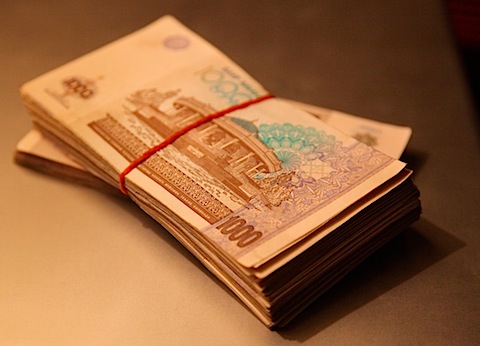
However, you quickly learn that the unofficial exchange rate is much, much higher. In Bukhara I was able to get 2,270 to the dollar - or about 40% more. Your introduction to this comes quickly as everyone - your hotelier, your guide, people on the street - will openly tell you that if you want to exchange dollars with them instead of the local bank, they'll give you a better rate.
My favourite experience was getting one of our guides to help us exchange money. He led me down a set of near-forested back alleys, across a street and into a market that consisted of near-identical stalls selling a uniquely Uzbek perspective on Western fashion. The tenth or so shop turned out to be our hookup and, amongst the jeans and fur-lined jacket-wearing mannequins, they casually started pulling out stacks of elastic-banded 1,000's to convert my money.
4.
When most people think of Uzbekistan, they think of Samarkand. It's the most famous of the former Silk Route cities here, and it has the most massive monuments. Beyond Samarkand, I knew nothing of this country before coming here. And, before coming here, if I'd only seen Samarkand, in my naivete, I would have been satisfied.
The first place most people go is the Shaki-Zinda complex. It's a series of mausoleums with an attached mosque. The finery of the tiling is incredible:
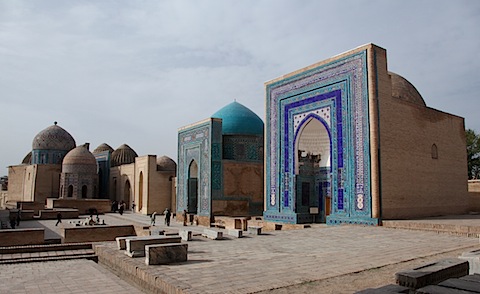
The entrance makes you feel like you are walking through an Islamic cavern:

Another major stop is the Gur Emir mausoleum, where the corpse of Amir Timur is kept. He's a polarizing figure: he's got a massive statue built to him in the geographic center of Tashkent; people in the provincial towns that he razed consider him a barbaric murderer.

Next to his tomb is the tomb of a holy man. There's an interesting tradition here where holy tombs are marked by a yak tail hung from a high post (and I am not making any of this up):
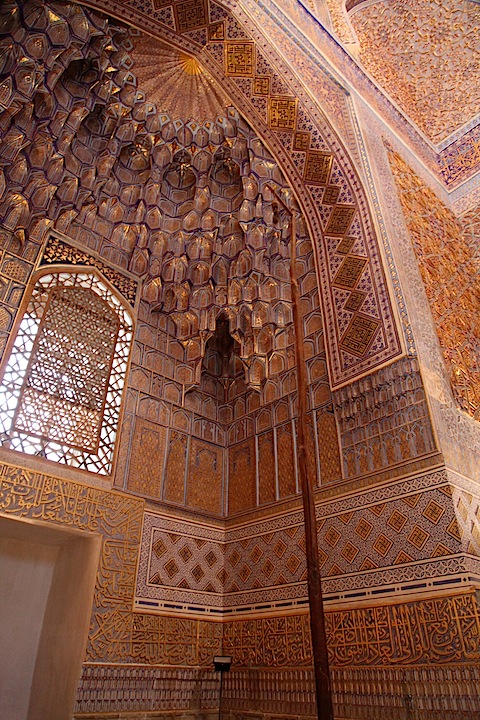
But the real reason people come to Samarkand is to see Registan Square: two beautiful madrasahs that balance a mosque. It's the postcard for all things Uzbek:

The details of the madrasahs are exquisite. The image below shows the one on the right in the photo above. The orange blobs above the arch are massive tiger lions (locals believe that they were tigers with the mane of a lion; alas they were conveniently hunted to extinction before someone did a proper drawing of one) with a face in the moon above their backs. These are unique in Islamic history as they come from a brief period when imams allowed designs that actually included visual representations of animals and - gasp- almost a human. I think the empire fell shortly after.

5.
If you ever find yourself in the Tashkent airport between 3 and 4 pm on a Tuesday you'll see an interesting sight. Airports are normally a polyglot demesne, but in Uzbekistan it takes on a whole new level as the two carousel arrival area receives two flights from Seoul and one each from Delhi, Kuala Lumpur, Beijing and Bangkok. Baggage careens randomly onto one of the carousels at an arbitrary time after your flight's arrival; the locals while away the time with flagrant disregard for the omnipresent no smoking signs.
Flying in Uzbekistan is also an interesting experience. You never have to worry about which airline you're flying as there's only one. Uzbekistan Airways is the only carrier that services the country and it does so via a fleet of battered Boeings and aging Iluskyins interspersed with the odd BA Avro and some things that look like they're converted from fighting forest fires. There must have been a garage sale on some Eastern European airlines in the 1990s.
They've also developed their own flying techniques, most notably the ability to drift into the sky and only then fire the throttle. Avid flyers will notice that this is the anithesis of North American flying where you hurtle down the runway as fast as you can and then gradually reduce thrust once you're in the air.
People also follow the quaint tradition of clapping upon a successful landing. However, I want to give Uzbek Air credit for it's landings: they are single handedly the smoothest landings I've ever felt. You literally touch down and find yourself noting "oh look, we're on the ground". The pilots also don't immediately hit the reverse thrust, so you have a few seconds to reacclimatize yourself with the Earth before you start to slow down. In fact, the pilot of our RJ 85 (yes, it is a model of plane, look it up) actually managed to slow the the plane to halt using only the brakes: no reverse thrust. It was, simply put, the best landing I have ever had. 10/10.
6.
Samarkand was followed by Bukhara - a UNESCO World Heritage site that I'd never heard of until I arrived there. It's a shame I'd never heard of it, as it's an ancient town that has over 500 monuments spread over a few kilometers. As you walk around the town you keep stumbling upon more and more history.
It would literally bore you to death if I were to list all the places we saw, but the highlights include the Kalon minaret and its associated mosque complex. You used to be able to climb to the top of it, but a few years back a geriatric German hurt himself (gee, maybe you shouldn't try to climb medieval minarets in second world countries...) and then had the gall to try and sue the Uzbek government (good luck winning). In a stubbornly autocratic state this unleashed bureaucratic terror and the minaret is now closed for non-existent "renovations":

To navigate to the complex you pass through several of the "trading domes" where merchants used to sell their wares. Now it's mostly souvenir trinkets:

On the outskirts of town you can visit the former Khan's summer palace. It's built in a combined European/Islamic style and shows the influence that the Czar had over his vassal states:
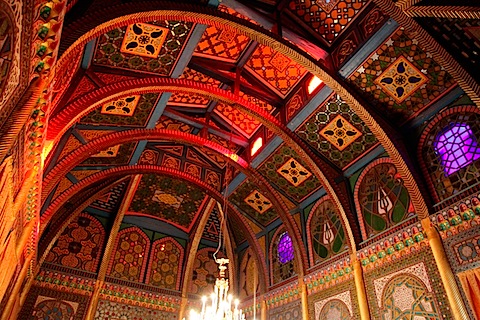
Here's the roof of the room where breakfast was served:
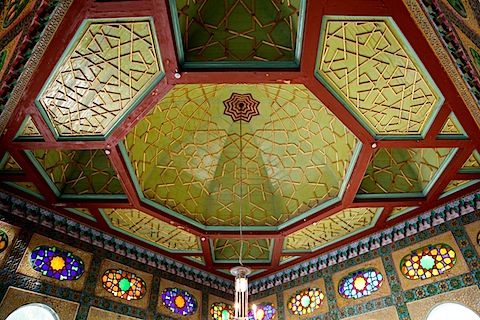
This palace also has one of the prettiest details I've seen anywhere on this trip. Many of the rooms have alcoves that use the cave design that's so common in mihrabs (alcove in a mosque that indicates the direction of Mecca); the cave is an allusion to the one where Mohammed first received his messages from God.
In the palace they've painted some of the alcoves white and then placed mirrors on the flat bottom of the cave elements. The effect is sublime:
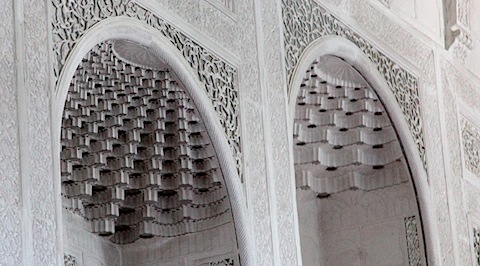
7.
I've never been on an organized multi-day tour before, but after this one, I could be convinced to take them in otherwise hard to visit places (to get into Uzbekistan you need a visa and that requires an invitation from a travel agency).
Here are some of the characters we met on our tour:
Anastasia. Our Russian guide in Tashkent. She showed up dressed to the nines in all matching black, heels, makeup and fingernails finished purple. She in her early twenties and has a master's in English - explaining her fluency. She's paying back the government (her education was free) by working for them; as she battles for choice roles against the sons and daughters of ministers and prominent citizens, she's learning how the game is played (Uzbekistan is 174th out of 180 in Transparency International's 2009 corruption rankings. Unlike golf, a low score is bad...).
Serik. Our Kazakh driver. He speaks a creole of broken English, florid Italian and the odd bit of German. He served in the military and his favourite motion is drawing his finger across his neck. He's full of humour, referring to an old vodka factory as a "communist mosque". He also refers to himself as "just the driver" but he is full of interesting wisdom, like the fact that the kindly old man who seems to run our hotel in Samarkand actually is the biggest crime boss in town
XYZ. Our guide in one of the cities. A hint of bitterness came into their voice when informing us that "of course, Uzbekistan has a new king now. But don't tell anyone I told you that!" This was a reference to Islam Karimov, the undisputed leader of Uzbekistan - and the only leader they've ever known.
He took office in 1990 and then, after Independence in 1991, started routinely winning 88% of the vote. Realizing that his popularity was making elections a waste of time and money, he extended his term from five to seven years. Next election is in 2014.
He shows up for all the photo ops and is so beloved for his wisdom that monuments and museums frequently contain tributes to him, like this one from the Ulugbek Observatory museum in Samarkand:
On the basis of National program of personnel training developed and carried out under the direct supervision of our President Islam Karimov the modern educational system fairly recognized by the world community is created in Uzbekistan.
8.
Our last stop was Khiva, another Silk Route trading town that I, sadly, knew nothing about prior to visiting. It's a stunning walled city, dotted with minarets (that you can actually go up!) and palaces, mosques, madrasahs and mausoleums.
While it's profile is beautiful, it actually appears quite grey:

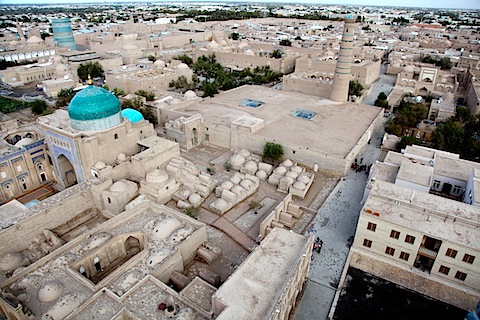
However, Khiva is home to some of the most incredible craftspeople you will ever meet and they have tiled the walls, carved the pillars and painted the roofs of all of their monuments:

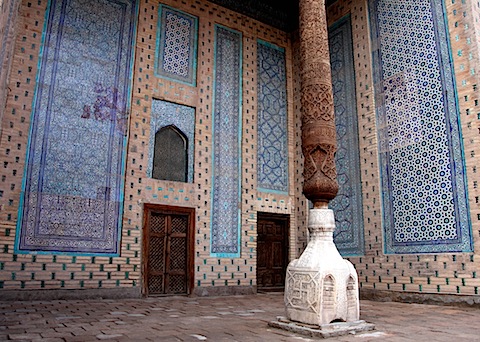
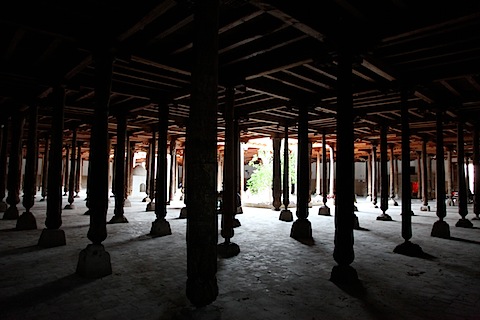
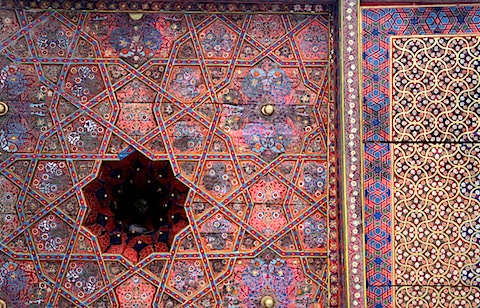
It's a beautiful city that we had to rush through in a day; I would have loved to have spent some more time there.
9.
Two things struck me with Uzbek society.
The first is that they are trying to practice autarky (creating an economy that is 100% self-sufficient). Unless they absolutely can't make it, they don't import it. This means that you can get a car, but unless you want to pay 100-150% of the price in import duty, you're going to be getting a locally-made Daewoo or a Chevrolet (and a weird model with a model name like "Lacetti" or "Matiz" or "Nexia"). And it's going to come in white or silver or black. Why would you want a different colour?
This also means that you can get a chocolate bar, but only one type. Ditto for cola, chips and a whole slew of other consumer products.
It also means that many services, like their airports, pretend at being modern, but since, for instance, there's only one airline and zero competition, things don't work as you'd expect. You'll have time to think about this when two flights leave from the same gate within five minutes of one another (there are not that many flights from Uzbekistan...) and four hundred people need to herd through a six foot wide door to get on unmarked buses to their respective flights. This problem was solved generations ago in competitive economies but autarky means that we'll have to wait a little longer for the solution to come to Uzbekistan.
The second thing I noticed is how conservative society is.
On our flight to Turkey they played the PG-13 movie "The Duchess". At the briefest hint of any inappropriate behaviour (usually an amourous scene), the movie would cut away to images of Air Uzbek planes flying over mountains.
The plane also had an informational pamphlet on AIDS that included the following gems:
Q: What is the relationship between HIV/AIDS and people traveling abroad?
A: By going to another country for employment opportunities, business trip or tourism purposes; as well as being away from family in a new environment, changing lifestyles, the person is more exposed to the risk of being infected by HIV/AIDS.
and:
Virus transmission may occur in the following cases:
1. Unprotected sexual intercourse with persons of easy behavior.
...
This is likely a holdover from the particularly conservative branch of Islam that was/is practiced here and led to sharia being law until 1920. In Khiva, when the law was revoked, there was a festival held where women could burn their body-covering paranjas. Many women burned them and upon returning home with hair uncovered, were stoned to death by their family members.
In fact, the paranja is possibly the most suffocating device ever created to spare a woman the lustful glances of men. It's a smock that drops down over a woman's feet and contains decorative sleeves: her actual arms are contained within the garment. The kicker is a veil that's a mesh of horse hair so that it's impossible to see any part of the woman's face:

Here's a too-short one modeled by Wendy:
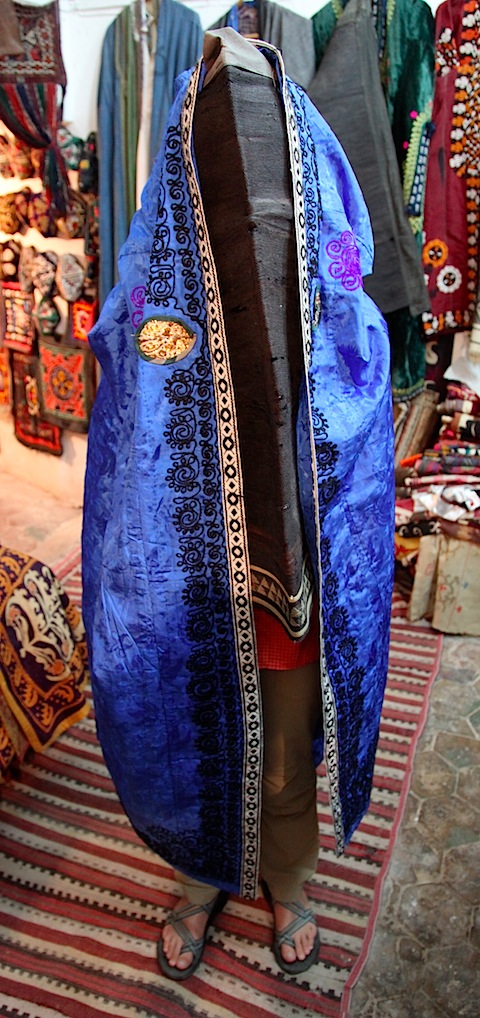
10.
The food in Uzbekistan is great. They specialize in lamb shish kebabs; if you get whole meat chunks, they come deliciously coated in salt to keep the flavour in during grilling:
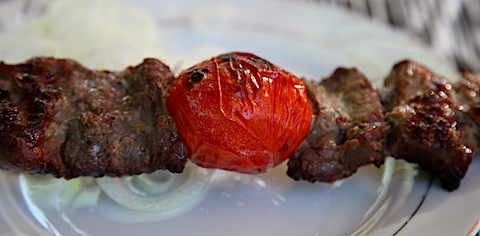
Here's the ground meat alternative:

The locals are also proud of their bread (and they bake it in a tandoor!). Each city has a variant on the same style of loaf; the people of Samarkand claim that there's is so good that it will stay fresh for 100 years:
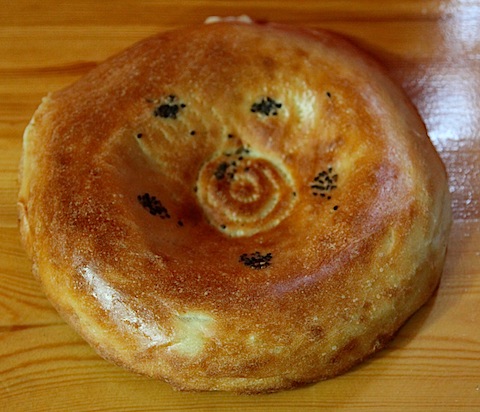
Quite a few dishes involved a stuffed surprise. This one was lamb crepes:

Here is a pepper stuffed with lamb and rice:
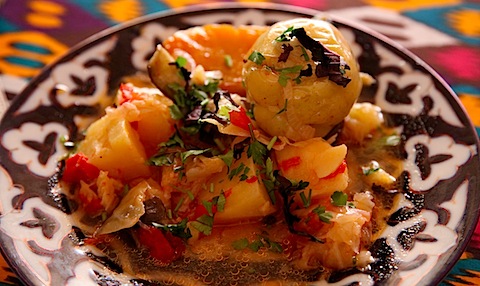
Again, the food is delicious (if you like lamb). It does take a little while to get used to the cooking style: since Uzbekistan is the world's 3rd largest cotton exporter, everything is cooked in cottonseed oil.
11.
A few other random things I noted while traveling there:
- Many Pakistanis come to Uzbekistan as it's close and cheap. Mostly large groups of men. One of our guides told us that they quickly visit the sites and then go out and get truly wasted as it's apparently rather difficult to do so back home
- They used to have slavery in Khiva and on a truly colossal scale. When it was outlawed in 1873, they found themselves with 40K new citizens versus a population that used to only contain 30K official citizens
- Names are impossible to pronounce here. One particularly overzealous soap opera actor has three apostrophes (!) in his last name
- The local instruments make beautiful music. Here's a guy demonstrating a few of them; skip ahead to 1:40 hear him play the Tor (12 strings). The Chang (75 strings) is right after: uzbek_music